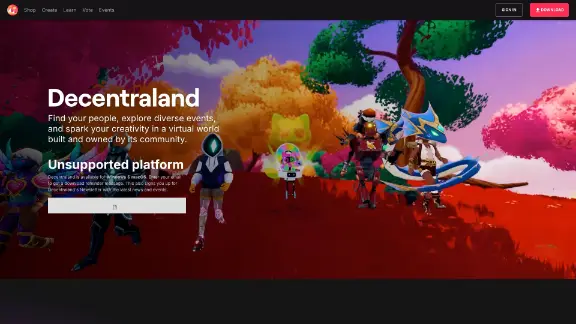Decentraland (MANA)
Decentraland is a decentralized virtual reality platform powered by the Ethereum blockchain. Within this platform, users can create, experience, and monetize their content and applications.
History
Decentraland was developed by Ariel Meilich and Esteban Ordano in 2015. It was launched following a successful initial coin offering (ICO) in 2017, raising $24 million over eight days. Token holders could claim a parcel of LAND by burning 1000 MANA tokens. During the ICO, 40% of the token supply was allocated to Crowdsale buyers, 20% to the Decentraland Foundation, 20% to the Team & Early Contributors, and 20% to the Community & Partners. Decentraland launched its closed beta in 2019 and became publicly accessible in February 2020.
Decentraland platform

| Ticker | MANA |
| Category | Entertainment |
| Website | https://decentraland.org/ |
| @decentraland | |
| https://www.reddit.com/r/decentraland | |
| Contract Addresses | |
|---|---|
| ethereum | 0x0f...42 Copied! Copied! |
| polygon-pos | 0xa1...d4 Copied! Copied! |
In Decentraland, users can buy and sell digital real estate, explore, interact, and play games within the virtual world. The platform has developed features such as interactive apps, in-world payments, and peer-to-peer communication. Decentraland uses two types of tokens: LAND and MANA.
LAND
LAND in Decentraland refers to non-fungible parcels into which the virtual world is divided. LAND's utility is based on its ability to host applications and its proximity to other attention hubs. Developers and content creators can build on LAND to reach their target audience. LAND can be purchased at a fixed cost of 1,000 MANA.
MANA
MANA is Decentraland's cryptocurrency token, an ERC-20 token used to acquire non-fungible ERC-721 LAND tokens. MANA is utilized for transactions within the virtual world, including purchasing avatars, wearables, and names on the Decentraland marketplace. MANA holders can also participate in governance through the DAO.
Technology architecture
The Decentraland protocol is structured into three layers.
Consensus layer
This layer tracks land ownership and content through an Ethereum smart contract. Each LAND parcel has unique coordinates and ownership details, allowing the Decentraland clients to update the state of the LAND smart contract.
Land content layer
Decentraland uses a decentralized storage system for distributing the content needed to render the world. This system enables the platform to operate without centralized servers, offering strong censorship resistance and allowing the world to persist as long as users distribute content.
Real-time layer
This layer facilitates user communication through peer-to-peer connections supported by servers hosted by landowners or third parties. These connections enable social interactions and applications within LAND parcels.
Utility
Decentraland's scripting language empowers developers to create applications, games, and dynamic 3D scenes. Users can gather around neighborhoods of shared interest, participate in advertising, collect digital assets, and engage socially within the platform.
Projects
Property renting
On December 7, 2022, Decentraland announced that users could officially rent out LAND through the digital marketplace, allowing for passive income generation.
Metaverse Fashion Week
Decentraland hosted its first Metaverse Fashion Week in March 2022, featuring high-end designers and NFT collections. The event provided a platform for self-expression through digital fashion. The second annual event took place in March 2023.
Satoshiverse
In June 2022, Decentraland introduced Satoshiverse, the first linked wearables in Decentraland. Linked Wearables are 3D representations of NFTs from outside Decentraland, used as Wearables in-world.
Fanz
On September 6, 2022, Decentraland announced Fanz, an NFT event ticketing platform developed through a Decentraland DAO grant. It facilitates secure ticket sales for metaverse events.
Petaverse
Petaverse is an interactive pet park in Decentraland, developed by Cominted Labs. It offers socialization and gaming opportunities for pet lovers in the metaverse.
BeatBlox
Announced on October 20, 2022, BeatBlox encompasses a music district in Decentraland, an NFT marketplace, and an academy. It aims to connect artists with fans in the Web3 space.
Worlds
On December 21, 2022, the Decentraland Foundation announced 'Worlds', personal 3D spaces tied to Decentraland NAMEs. Worlds serve as experimental spaces for creation and events without the need for LAND ownership.
Wilderness P2E
Wilderness P2E, announced on January 20, 2023, is a role-playing game where players become wizards in a fantasy world within Decentraland. Developed by Neha Singh and Ryan Pal, the game offers an immersive Magic Combat experience.
